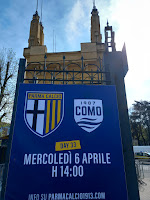SHEFFIELD AND HALLAMSHIRE COUNTY LEAGUE DIVISION ONE, WOMBWELL TOWN 3-1 DENABY MAIN, ATTENDANCE: 224
As we reach the business end of, thankfully, a largely uninterrupted season games that actually have something riding on them start to become few and far between. However if you dig a little deep, for example at step 7 or below, then you can find some crackers. My game of choice today was no exception.
I crossed over the Pennines to South Yorkshire for a massive game in the Sheffield and Hallamshire County Senior League. It was 3rd vs 4th in the First Division (which sits at step 8 in the non-league pyramid) where Wombwell Town needed to avoid defeat to gain promotion to the Premier Division, whilst opponents Denaby Main needed to win the game, then hope Wombwell slip up somewhere in their remaining games in hand, thus allowing them to overtake the Wellers and snatch a promotion spot. It was certainly all to play for this afternoon.
Wombwell is a former mining town around 5 miles from Barnsley. There were once two collieries in operation, Mitchells Main and Wombwell Main, but these closed in 1956 and 1969 respectively.
There have been numerous football clubs over the years that have represented the town. The first Wombwell Town, founded in the 1890's, won the inaugural Yorkshire league and were the first Wombwell team to enter the FA Cup. This club folded in the early 1900's. Next was Wombwell Rising Star who lasted a season around 1904. Another Wombwell Town was formed in 1920, and reached the 1st round of the FA Cup in 1930, before folding in 1934. The fourth team to represent the town was the one that lasted the longest. Wombwell Athletic was founded just after the second World War and lasted over 50 years, until the millennium. This club played in the Yorkshire League before becoming founder members of the Northern Counties East League in 1982 before they joined the Central Midlands League in 1988. They were in the Sheffield and Hallamshire League, and known as Wombwell Town, when they were dissolved in 2000.
The latest Wombwell Town incarnation was founded in 2018 by former Barnsley FC professionals Karl Rose and Doug O’Connor. The home ground is the Recreation Ground, where the last Wombwell Town had previously played. The club were placed in division two of the Sheffield and Hallamshire League and they won this at the first attempt. The following season the club were on course to make it back-to-back promotions but in March 2020 the Coronavirus pandemic struck and the season was abandoned. Season 2020/21 was also a write off, with just 5 games being played, so finally after two years the club were now in a position to finally clinch that promotion.
It was not a good start for The Wellers as Denaby took the lead after 20 minutes when Christian Baxby raced through to score. Brad Kerr equalised for Wombwell after 37 minutes to ensure it was all square at the break.
Will Harling put the Wellers in front after 69 minutes before Kerr netted his second after 85 minutes to wrap up victory and with it promotion. It was a well deserved victory and I offer my congratulations to The Wellers. All that is left for Wombwell to do now is to win seven points from their three remaining games to clinch the title. Good luck!





















.jpg)










































